Nuclear fusion – live: Scientists announce major ‘limitless clean energy’ breakthrough
- Oops!Something went wrong.Please try again later.
The United States has announced a nuclear fusion breakthrough, a historic step towards the promise of “near-limitless” clean energy.
“It will go down in the history books,” said Energy Secretary Jennifer Granholm on Tuesday in Washington DC alongside scientists from the Lawrence Livermore National Laboratory in California.
For 70 years, hundreds of scientists and engineers have attempted to replicate the energy process of atoms fusing together that powers the sun and other stars.
It is an enormously complex - and expensive - process which is highly unstable due to the high temperatures and pressures involved.
Now, for the first time, the California lab team used lasers to achieve a “net energy gain”, producing more energy in a fusion reaction than was used to ignite it.
Scientists heralded the breakthrough but said there were still decades of work to be done before fusion would be powering our everyday lives.
Nevertheless, the fusion breakthrough has the potential to significantly impact the trajectory of the climate crisis - driven by the planet-heating emissions created by burning fossil fuels.
Key Points
Scientists finally achieve ‘holy grail’ of nuclear fusion power
Nuclear fusion breakthrough holds promise of ‘near-limitless’ clean energy
‘Massive challenges’ facing researchers working to implement new science
US scientists achieve ‘holy grail’ net gain nuclear fusion reaction: report
VIDEO: Scientists achieve historic fusion ‘ignition’ to produce ‘near-limitless’ clean energy
Experiment recreated ‘certain conditions that are only found in the stars and sun'
Tuesday 13 December 2022 15:36 , Gustaf Kilander
Secretary Granholm said on Tuesday that the fusion experiment recreated “certain conditions that are only found in the stars and sun”.
“Ignition allows us to replicate for the first time certain conditions that are only found in the stars and sun. This milestone moves us one significant step closer to the possibility of zero carbon abundant fusion energy powering our society,” she added. “This is what it looks like for America to lead, and we’re just getting started.”
“If we can advance fusion energy, we could use it to produce clean electricity, transportation fuels, power, heavy industry and so much more,” Ms Granholm added.
‘It’s an engineering marvel beyond belief,’ Biden science advisor says
Tuesday 13 December 2022 15:41 , Gustaf Kilander
The director of the White House Office of Science and Technology Policy, Arati Prabhakar, who also serves as President Joe Biden’s science advisor, said on Tuesday that the nuclear fusion achievement is a “scientific milestone,” calling it an “engineering marvel”.
“It’s a century since we figured out it was fusion that was going on in our sun and all the other stars. And in that century, it took so many different kinds of advances that ultimately came together to the point that we could replicate that fusion activity in a laboratory,” Dr Prabhakar added.
“It took not just one generation but generations of people pursuing this goal. It’s a scientific milestone. ... It’s also an engineering marvel beyond belief,” she said.
‘Very significant hurdles’ to get commercial nuclear fusion
Tuesday 13 December 2022 15:56 , Louise Boyle
LLNL Director Dr Kim Budil said on Tuesday that while there were “very significant hurdles” in science and technology to getting to commercial nuclear fusion, it now was likely that it would happen in a “few” decades as opposed to 60 or 70 years as had been believed previously.
The fusion breakthrough has the potential to significantly impact the trajectory of the climate crisis - driven by the planet-heating emissions created by burning fossil fuels.
“Fusion ‘ignition’ occurs when the power emitted by the fusion reactions exceeds the losses. Experiments at the National Ignition Facility are a bit like striking a match, with this experiment the match kept burning. This is a momentous achievement after 50 years of research into Laser Fusion,” said Dr Robbie Scott, of the Science and Technology Facilities Council’s Central Laser Facility Plasma Physics Group, who contributed to this research.
He continued: “Fusion has the potential to provide a near-limitless, safe, clean, source of carbon-free baseload energy.
Read more:
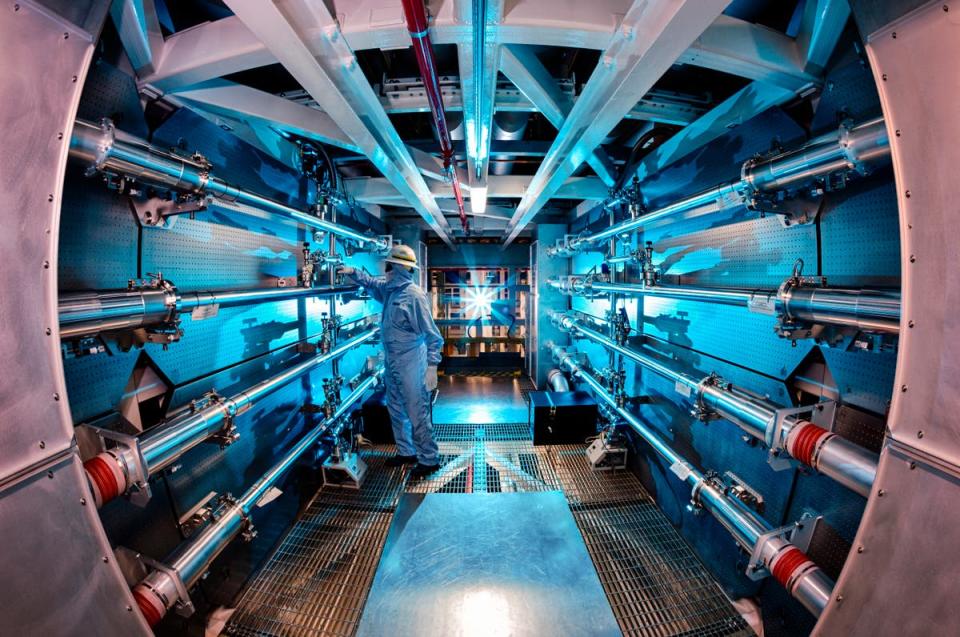
Nuclear fusion breakthrough holds promise of ‘near-limitless’ clean energy
‘Breakthroughs’ and ‘setbacks’ ahead as work continues
Tuesday 13 December 2022 16:15 , Gustaf Kilander
The under-secretary of Energy for Nuclear Security and the administrator of the National Nuclear Security Administration (NNSA), Jill Hruby said on Tuesday that this work will have upcoming “breakthroughs” and “setbacks.”.
She said the aims of the work include “promoting national security” and “pushing towards ... a clean energy future”.
She added that there isn’t a “more dedicated or talented group of scientists” than those working on this project.
Laboratory director shortens expected timeline for commercial fusion energy
Tuesday 13 December 2022 16:30 , Gustaf Kilander
The director of the Lawrence Livermore National Laboratory, Kim Budil, said that to “realize commercial fusion energy ... many, many things” need to be done, such as creating “many, many fusion ignition events per minute”.
She added that a “robust system of drivers” is needed “to enable that”.
She said that this will “probably” take “decades” but “not six decades, not five decades – which is what we used to say”.
“I think it’s moving into the foreground and probably with concerted effort and investment, a few decades of research on the underlying technologies could put us in a position to build a power plant,” she said.
Fusion achievement may impact climate crisis
Tuesday 13 December 2022 16:45 , Louise Boyle
The fusion breakthrough has the potential to significantly impact the trajectory of the climate crisis - driven by the planet-heating greenhouse gas emissions from burning fossil fuels. Fusion does not produce greenhouse gases nor long-lived radioactive waste.
“This astonishing scientific advance puts us on the precipice of a future no longer reliant on fossil fuels but instead powered by new clean fusion energy,” Senate Majority Leader Charles Schumer said.
The US Department of Energy is restarting a broad-based, coordinated IFE program in the US. “Combined with private-sector investment, there is a lot of momentum to drive rapid progress toward fusion commercialization,” the LLNL public affairs office said in a statement.
‘The stuff that generates this energy is wildly unlimited and it is clean,’ former laboratory technologist says
Tuesday 13 December 2022 17:00 , Gustaf Kilander
The former chief energy technologist at Lawrence Livermore, Julio Friedmann, told CNN that “unlike coal, you only need a small amount of hydrogen, and it is the most abundant thing found in the universe”.
“Hydrogen is found in water so the stuff that generates this energy is wildly unlimited and it is clean,” he added.
“From an energy perspective, it can’t be an energy source if you’re not getting out more energy than you’re putting in,” he told CNN. “Prior breakthroughs have been important but it’s not the same thing as generating energy that could one day be used on a larger scale.”
VIDEO: Today Explained: U.S. Hits Breakthrough in Quest for Fusion Energy
Tuesday 13 December 2022 17:20 , Gustaf Kilander
From 10 shots a week to 10 shots a second
Tuesday 13 December 2022 17:40 , Gustaf Kilander
NIF, the most powerful laser in the world, is approximately the size of a sports stadium, but it works slowly and it’s not the most efficient of machines, on average conducting about 10 shots each week.
In any commercial facility, a laser would have to average around 10 shots a second, The New York Times notes.
The facility currently uses much more energy as a whole than fusion reactions create.
PHOTOS: Department of Energy announces nuclear fusion breakthrough
Tuesday 13 December 2022 18:00 , Gustaf Kilander
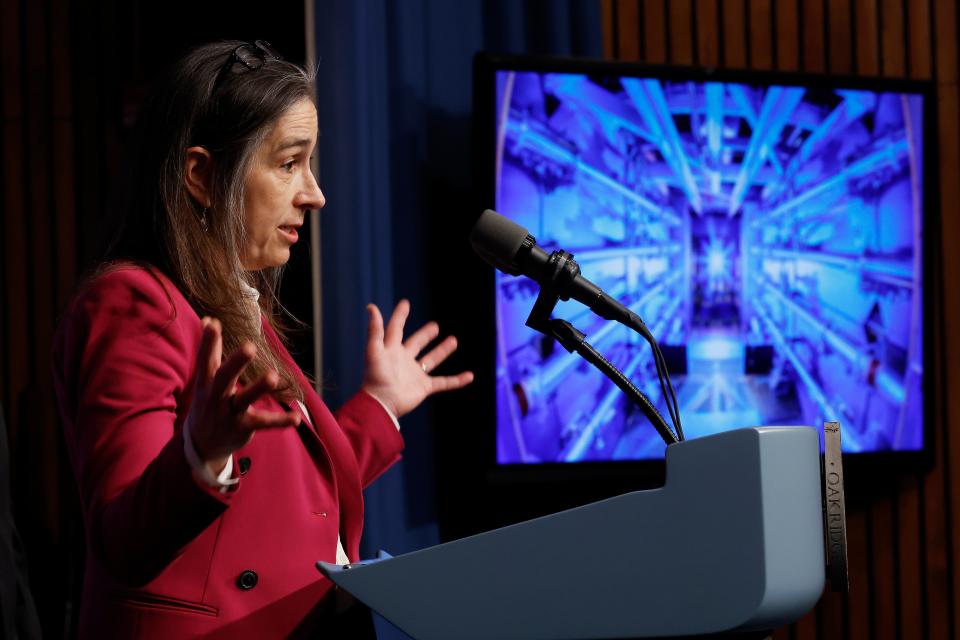
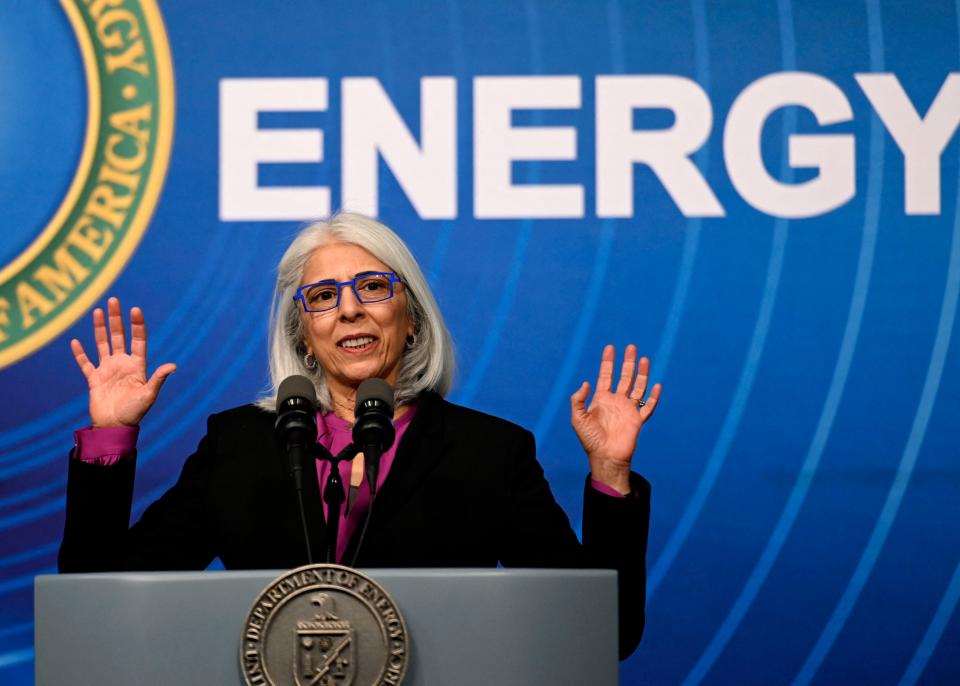
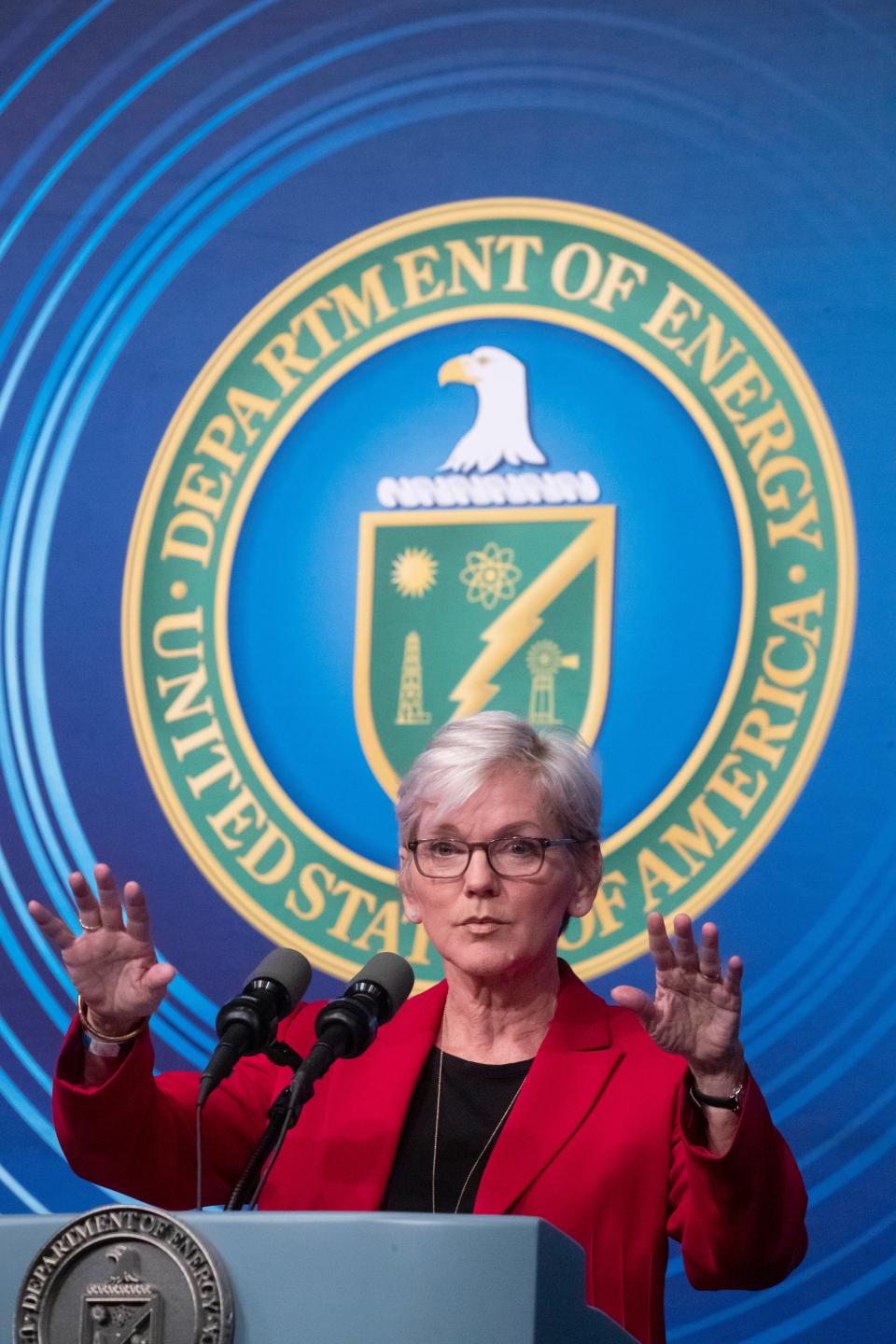
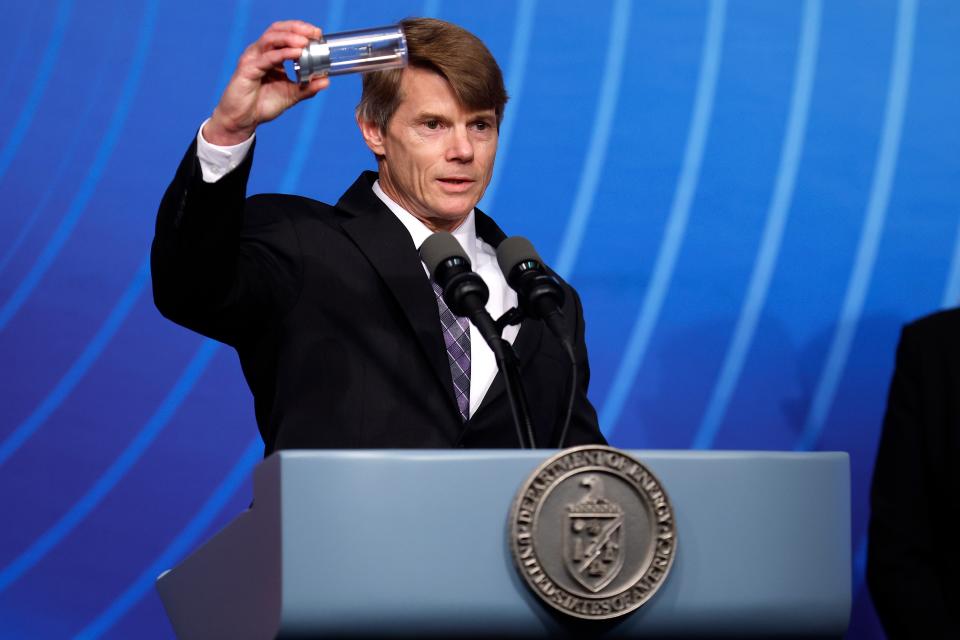
Energy Secretary says fusion could help put US on path to zero carbon emissions
Tuesday 13 December 2022 18:25 , Gustaf Kilander
US Secretary of Energy Jennifer Granholm said on Tuesday that the nuclear fusion achievement revealed on Tuesday “essentially unlocked a whole new source of clean energy”.
“More energy came out of these reactions than put into it,” she said, adding to CNN that “if we could get this scale, this will be an amazing endeavour of ... achieving the goal of zero-carbon emission power”.
“We have a goal of getting to net-zero energy by 2050, so that would be within that time frame. But now that this breakthrough has happened, the scientists can go to work on improving the process,” she added, referencing President Joe Biden’s stated goal of creating a commercial fusion reactor within 10 years.
“We have a lot more work to make sure it’s not just the United States, it’s other countries as well. So our example, both in the fusion example — as well as in all of these other technologies and policies — are being looked at very seriously by other countries who also want to do their part,” she said.
Experiment simulated ‘the conditions of a star'
Tuesday 13 December 2022 18:50 , Gustaf Kilander
Jill Hruby, the under-secretary for nuclear security, said that the US has taken “the first tentative steps towards a clean energy source that could revolutionize the world”.
The experiment included “192 high-energy lasers” being aimed at “a target about the size of a peppercorn, heating a capsule of deuterium and tritium to over three million degrees Celsius and briefly simulating the conditions of a star and achieving ignition”.
Arati Prabhakar, the Biden science advisor, said that researchers “shot a bunch of lasers at a pellet of fuel and more energy was released from that fusion ignition than the energy of the lasers”.
VIDEO: ‘This is one of the most impressive scientific feats of the 21st century,’ energy secretary says
Tuesday 13 December 2022 19:15 , Gustaf Kilander
Energy @SecGranholm on fusion ignition achievement last week: " It's the first time it has every been done in a laboratory, anywhere in the world. Simply put, this is one of the most impressive scientific feats of the 21st century...This is a BFD." pic.twitter.com/jZ8TPBad34
— CSPAN (@cspan) December 13, 2022
Scientists achieve energy gain in lab experiments
Tuesday 13 December 2022 19:40 , Gustaf Kilander
Fusion has always been a strong alternative when concerned about the impact on the climate of emissions from other energy sources.
Fusion combines hydrogen atoms into helium within the sun and the stars, which leads to sunlight and warmth heating the planets.
The process has been proven to be a clean source of energy in lab experiments, unlike fossil fuels, and nuclear energy which leaves behind radioactive waste.
But until now, scientists have been unable to retain more energy from the reactions than they used.
At 1.03am on 5 December, scientists used 192 lasers to blast a cylinder holding a small amount of hydrogen, creating three megajoules of energy while only putting in 2.05 megajoules, The New York Times reported.
PHOTOS: Scientists reveal new discovery at Department of Energy press briefing
Tuesday 13 December 2022 20:10 , Gustaf Kilander
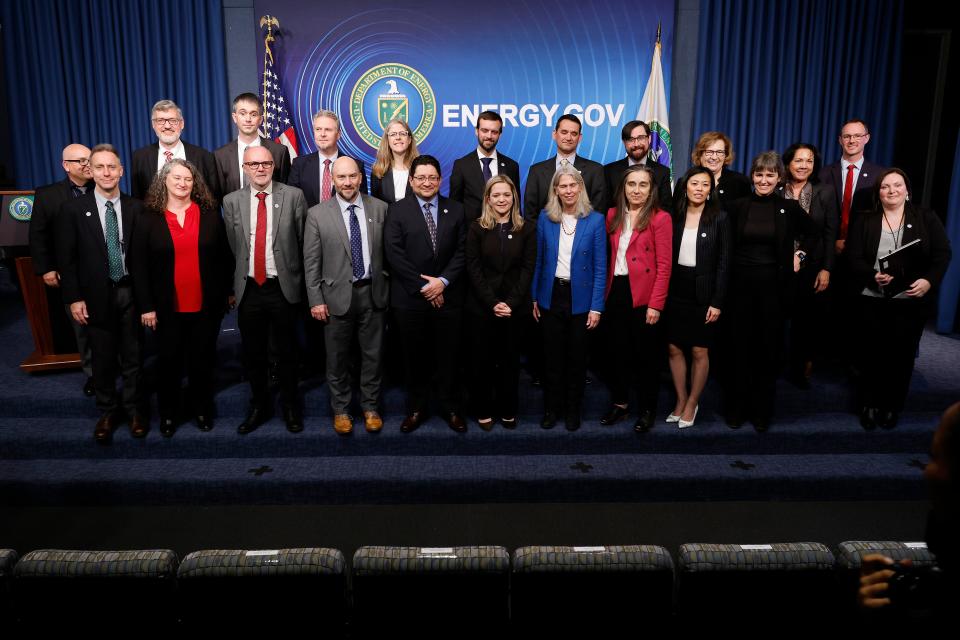
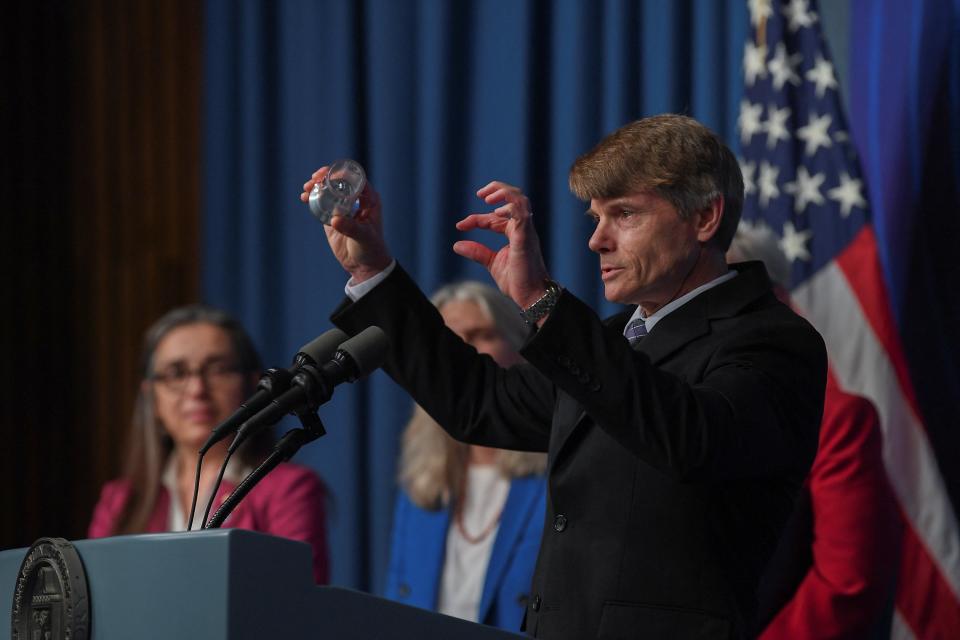
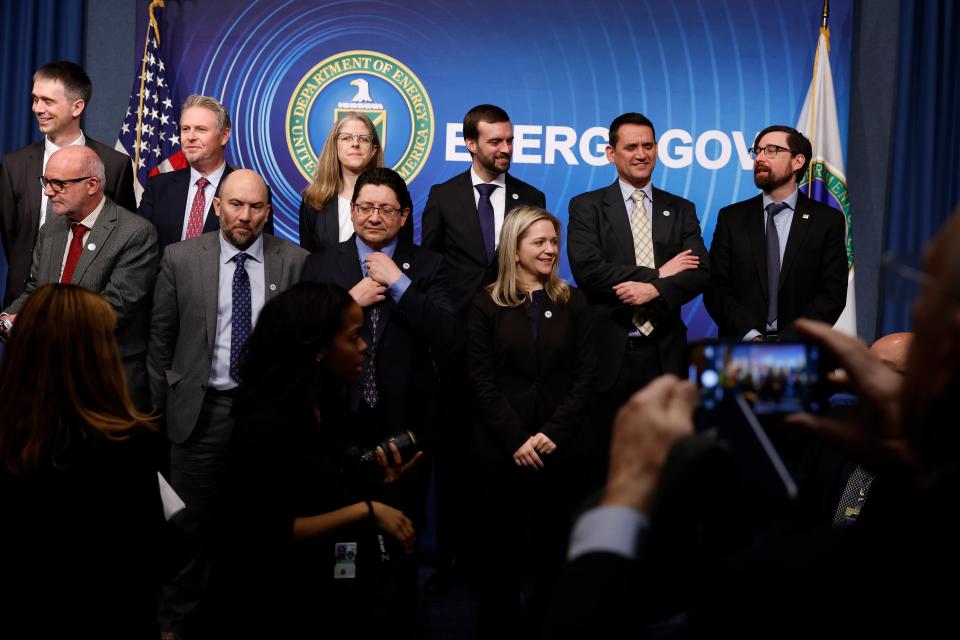

‘300 megajoules at the wall, two megajoules at the laser'
Tuesday 13 December 2022 20:40 , Gustaf Kilander
The Department of Energy declared the 5 December nuclear fusion energy as a success because when the hundreds of lasers struck the cylinder holding a small amount of hydrogen, 2.05 megajoules were shot at the target and 3.15 megajoules of energy came out.
But that didn’t factor in the energy that was required to create the lasers themselves – so-called wall-socket energy, The Washington Post noted.
The director of the Lawrence Livermore Laboratory, Kim Budil, said at the press conference on Tuesday that there were “300 megajoules at the wall, two megajoules at the laser”.
‘Success, however long it takes, would be transformational'
Tuesday 13 December 2022 21:10 , Harry Cockburn
The long-held promise of nuclear fusion is that it could provide energy in such abundance that it would effectively replace all other forms of power, bringing free, unlimited energy to people around the world, revolutionising our societies, and helping to bring the emissions driving the climate crisis to heel.
Scientists are now cautiously optimistic that we could be witnessing a major breakthrough with the potential to radically alter the energy landscape.
Professor Sir Robin Grimes, of Imperial College London, said on Monday: “This is a key step on a possible pathway to commercial fusion. It demonstrates and underpins our basic understanding of the physics, and is an engineering triumph.
“Nevertheless, extracting this energy in a way that it can be harnessed, and developing the materials that can stand up to continuous operation, are massive challenges. There is no doubt, the prize is worth the effort. Success, however long it takes, would be transformational.”
Laser used in experiment housed in football stadium complex
Tuesday 13 December 2022 21:40 , Gustaf Kilander
The laser needed to create the required reaction was so large that it was housed in a football stadium complex, The Washington Post noted.
It was built after the project ran over budget and faced years of delays.
Producing electricity from fusion would need the reaction, referred to as “ignition,” to take place every second of the day, the paper reported.
Reaching that point would require engineering on a massive scale. Merely creating a small amount of energy gain puts so much pressure on the expensive equipment that it at times breaks.
The risk posed by unguarded optimism about unlimited free energy
Tuesday 13 December 2022 22:10 , Harry Cockburn
The risk posed by unguarded optimism about the prospect of unlimited free energy is that it could undo the small steps that have already been taken to decarbonise the energy sector and other industries that have largely depended on fossil fuels.
Just as polluting industries are already factoring in scarcely adequate carbon capture technology in pursuit of their own net zero targets, fusion must not be treated as a climate crisis “get out of jail free” card.
The technology cannot be ready within the time window required to meet the climate targets governments are already failing to meet. Our society’s priority must remain the rapid curtailment of greenhouse gas emissions.
It may not be as sexy, but a combination of energy efficiency, insulation, heat pumps and a broader rollout of renewables remains our best shot for tackling the climate crisis and building greater energy security.
VIDEO: Laboratory shares footage outlining experiment process
Tuesday 13 December 2022 22:40 , Gustaf Kilander
On Dec. 5, 2022, a team at LLNL's @lasers_llnl conducted the first controlled fusion experiment in history to achieve fusion ignition. Also known as scientific energy breakeven, the experiment produced more energy from fusion than the laser energy used to drive it. pic.twitter.com/t9htICEcuh
— Lawrence Livermore National Laboratory (@Livermore_Lab) December 13, 2022
‘We had some rocky times’: Member of Congress fought efforts to defund National Ignition Facility
Tuesday 13 December 2022 23:25 , Gustaf Kilander
California Representative Zoe Lofgren worked against attempts to defund the National Ignition Facility.
“We had some rocky times,” she told The Washington Post. “To see they have achieved ignition is fabulous. It is a profound breakthrough that brings an enticing promise that we could produce a nonpolluting, basically limitless source of energy.”
Commercial fusion energy had been attempted for some time as results in national labs have disappointed some and amid the possibility that funding for experiments may dry up.
‘Useful energy production from fusion explosions faces enormous challenges'
00:05 , Gustaf Kilander
A professor of nuclear science and engineering at MIT, Ian Hutchinson, told The Washington Post that the work conducted at the National Ignition Facility is “not aimed at fusion energy production but at understanding fusion explosions”.
“Useful energy production from miniature fusion explosions still faces enormous engineering challenges, and we don’t know if those challenges can be overcome,” he added.
Breakthrough will pave the way for advancements in national defense, energy secretary says
00:50 , The Associated Press
The breakthrough will pave the way for advancements in national defense and the future of clean power, Energy Secretary Jennifer Granholm and other officials said.
“Ignition allows us to replicate for the first time certain conditions that are found only in the stars and the sun,″ Granholm told a news conference in Washington. “This milestone moves us one significant step closer to the possibility of zero-carbon abundant fusion energy powering our society.″
Fusion ignition is “one of the most impressive scientific feats of the 21st century,″ Granholm said, adding that the breakthrough “will go down in the history books.″
‘It’s almost like it’s a starting gun going off'
01:35 , The Associated Press
Proponents of fusion hope that it could one day offer nearly limitless, carbon-free energy and displace fossil fuels and other traditional energy sources. Producing energy that powers homes and businesses from fusion is still decades away. But researchers said the announcement marked a significant advance nonetheless.
“It’s almost like it’s a starting gun going off,” said professor Dennis Whyte, director of the Plasma Science and Fusion Center at the Massachusetts Institute of Technology and a leader in fusion research. “We should be pushing towards making fusion energy systems available to tackle climate change and energy security.”
VIDEO: U.S. Scientists Announce Fusion Energy Breakthrough
02:20 , The Independent
‘A lot of good news on the horizon’: Biden hails fusion success
03:05 , The Associated Press
Fusion works by pressing hydrogen atoms into each other with such force that they combine into helium, releasing enormous amounts of energy and heat. Unlike other nuclear reactions, it doesn’t create radioactive waste.
President Joe Biden called the breakthrough a good example of the need to continue to invest in research and development.
“Look what’s going on from the Department of Energy on the nuclear front. There’s a lot of good news on the horizon,” he said at the White House.
New science unlikely to impact current climate crisis, physics professor says
04:00 , Gustaf Kilander
A professor of physics at the University of Oxford, Justin Wark, told The Guardian that “in some senses everything changes, in another, nothing changes”.
“This result proves what most physicists always believed – fusion in the laboratory is possible. However, the obstacles to be overcome to make anything like a commercial reactor are huge, and must not be underestimated,” he added.
“I understand that everyone wants to think of this as being the great solution to the energy crisis. It is not, and whoever says it is with any certainty is misleading,” he told the paper.
“It is highly unlikely that fusion will impact on a timescale sufficiently short to impact our current climate change crisis, so there must be no let up on our efforts in that regard,” he added. “The latest results also show that the basic science works – the laws of physics do not prevent us from achieving the goal – the problems are technical and economic. As Niels Bohr, the Nobel Prize-winning atomic physicist once said, ‘prediction is very difficult, especially when it is about the future.’”
‘Challenges remain’ despite ‘fantastic scientific breakthrough’
05:00 , Gustaf Kilander
A reader in nuclear materials at Imperial College London, Dr Mark Wenman, told The Guardian that the nuclear fusion accomplishment is a “fantastic scientific breakthrough – something we have not achieved in 70 years of trying”.
But he added that “challenges remain of how you can get the energy out of the system, how you can sustain the energy for long enough to be useful, how you scale up that energy and whether the energy can be cheap enough to compete with other sources”.
Lasers create superheated plasma environment where fusion may occur
06:00 , The Associated Press
Billions of dollars and decades of work have gone into fusion research that has produced exhilarating results — for fractions of a second.
Previously, researchers at the National Ignition Facility, the division of Lawrence Livermore where the success took place, used 192 lasers and temperatures multiple times hotter than the center of the sun to create an extremely brief fusion reaction.
The lasers focus an enormous amount of heat on a small metal can. The result is a superheated plasma environment where fusion may occur.
Without an engine and tires ‘you can’t say that you have a car’
07:00 , The Associated Press
Riccardo Betti, a professor at the University of Rochester and expert in laser fusion, said there’s a long road ahead before the net energy gain leads to sustainable electricity.
He likened the breakthrough to when humans first learned that refining oil into gasoline and igniting it could produce an explosion.
“You still don’t have the engine, and you still don’t have the tires,” Betti said. “You can’t say that you have a car.”
VIDEO: US scientists announce fusion energy breakthrough
08:00 , The Independent
Fuel has to be hotter that the centre of the sun
09:00 , The Associated Press
The net energy gain achievement applied to the fusion reaction itself, not the total amount of power it took to operate the lasers and run the project. For fusion to be viable, it will need to produce significantly more power and for longer.
It is incredibly difficult to control the physics of stars. Dennis Whyte, director of the Plasma Science and Fusion Center at the Massachusetts Institute of Technology and a leader in fusion research, said the fuel has to be hotter than the center of the sun. The fuel does not want to stay hot — it wants to leak out and get cold. Containing it is a challenge, he said.
Results from the California lab exceeded expectations, said Jeremy Chittenden, a professor at Imperial College in London specializing in plasma physics.
Although there’s a long way to go to turn fusion into a usable power source, Chittenden said, the lab’s achievement makes him optimistic that it may someday be “the ideal power source that we thought it would be” — one that’s carbon-free and runs on an abundant form of hydrogen that can be extracted from seawater.

